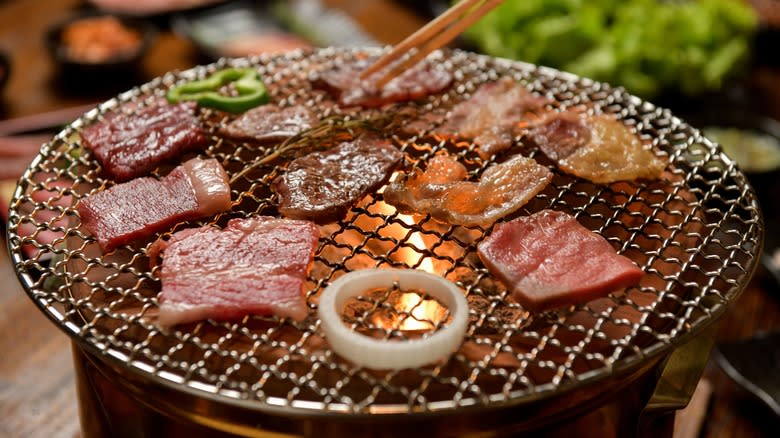How Japanese Restaurants Garnish Steak From The Grill

From Turkish-style charcoal-cooked kebabs to Mexican marinated carne asada, grilled meats take on a wide variety of forms worldwide. In Japan, the grilling technique is all about minimalist perfection, ideally managing only a handful of factors. These include the utilized charcoal -- often the evenly-burning binchotan -- as well as the specific butchering. Japanese grilling practice favors small bite-sized pieces accentuated through direct flavors. Bites of meat are threaded onto skewers for grilling over coals or prepared using vessels like hibachi bowls and teppanyaki griddles. Once off of the grill, the meat's garnished with a simple treatment: a sprinkling of powdered pepper and a lemon slice.
Japanese spices like ground sansho peppercorns or shichimi togarashi imbue an initial bright dose of flavor, that quickly subsides to showcase the meat. Further complements may also include dollops of pastes, like wasabi, mustard, or citrusy yuzu kosho. And sometimes, there's a dipping sauce, oftentimes soy-based. Diners then create their own bite pairings, matching richly flavored meats with bright, bold flavors. Such a dining style creates a do-it-yourself flavor experience as opposed to American-style plated steak meals.
Read more: Your Guide To The Different Cuts Of Steak
Japanese Steak Is Served With Doses Of Bright, Mouth-Watering Flavors

Grilled steak is a relatively young addition to Japanese cuisine. Prior to the introduction of Western culinary techniques during the 19th century, beef was not a commonly consumed protein. However, into the 20th century, a distinctly Japanese system of butchering and preparation arose.
Much like sashimi, sharp knives and deft cuts separate bits of meat, cut efficiently to minimize waste. Especially with the popularity of wagyu, keeping tender tissue and fat structures is a butcher's priority. As a result, each small bite of meat is optimized for its flavor and consistency. And in teppanyaki restaurants, chefs showcase flavors of meat through knife skills rather than complex sauces and dish assembly.
Prior to grilling, the meat is either only salted or drizzled with tare, a sweet grilling sauce. It only takes a few minutes over the heating source before the steak's ready to serve. The result's delicious as is, but the employed citrus slice, pepper blends, and condiments imbue an extra pop of flavor. They enable salivation and imbue an additional complex edge to the meal, whether it's tangy citrus, chile's heat, or a soy's salty character. Such complements keep the appetite flowing, leading to an engaging and delicious steak meal comprised of many bites.
Read the original article on Tasting Table.

 Yahoo Lifestyle
Yahoo Lifestyle 
